Case Study: Randomized Control Trial of Music Therapy for Depression
VerifiedAdded on 2022/12/22
|11
|2470
|1
Case Study
AI Summary
This case study critically analyzes a randomized controlled trial (RCT) investigating the efficacy of music therapy combined with standard care versus standard care alone for treating depression in working-age individuals. Conducted by Erkkilä et al. (2011), the study recruited 79 participants diagnosed with depression and utilized music therapy as an intervention alongside standard care. The study measured depression, anxiety, general functioning, quality of life, and alexithymia. The analysis, employing the CASP tool, evaluates the trial's randomization, blinding, allocation concealment, and sample size adequacy. The results indicated that music therapy showed significant improvements in reducing depression and anxiety symptoms. The case study also discusses the potential clinical application of these findings, suggesting that the intervention could be beneficial for patients experiencing depression and anxiety, leading to improved quality of life and self-esteem. The study's internal and external validity are also discussed, concluding that the study is both internally and externally valid, and the intervention causes no harm.
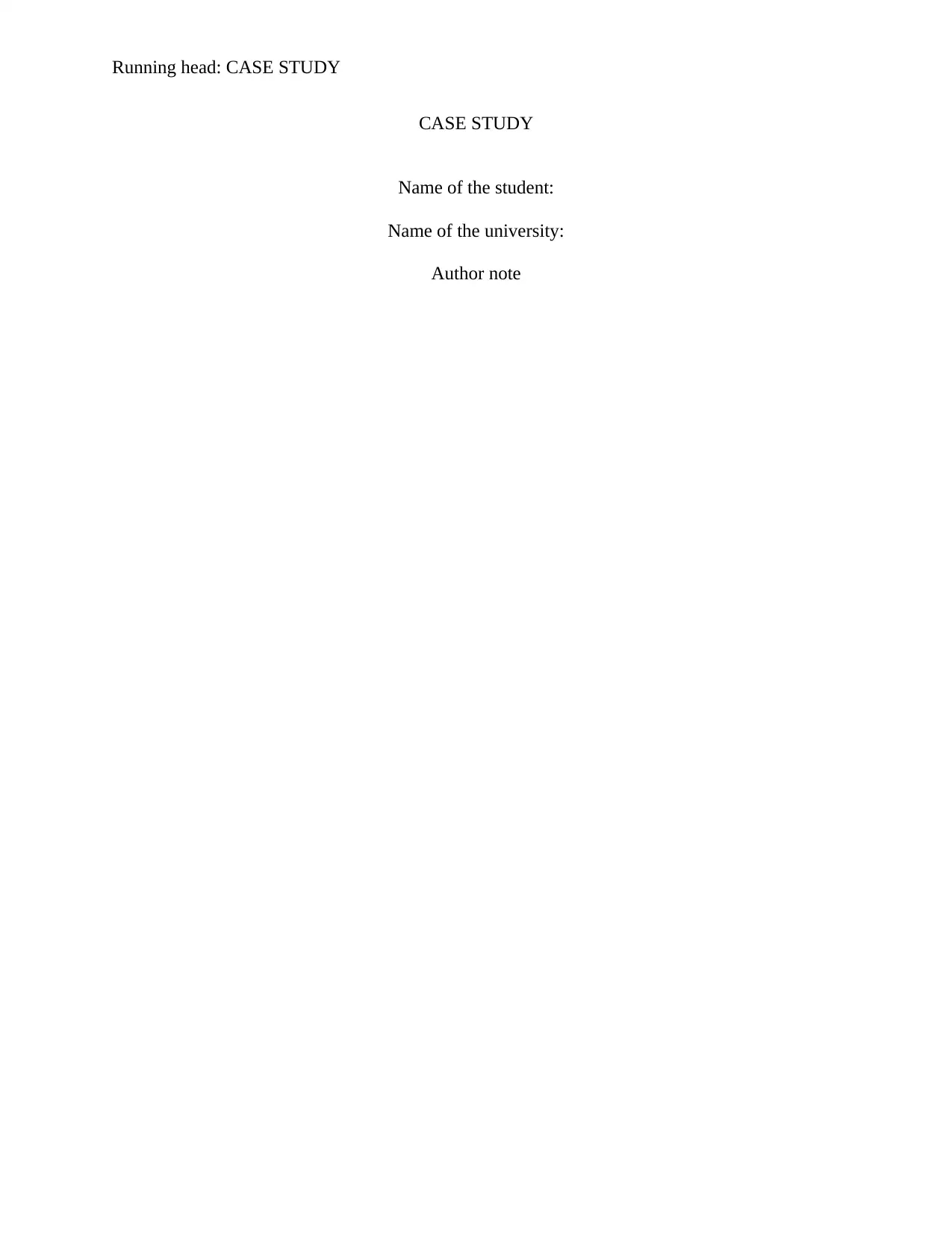
Running head: CASE STUDY
CASE STUDY
Name of the student:
Name of the university:
Author note
CASE STUDY
Name of the student:
Name of the university:
Author note
Paraphrase This Document
Need a fresh take? Get an instant paraphrase of this document with our AI Paraphraser
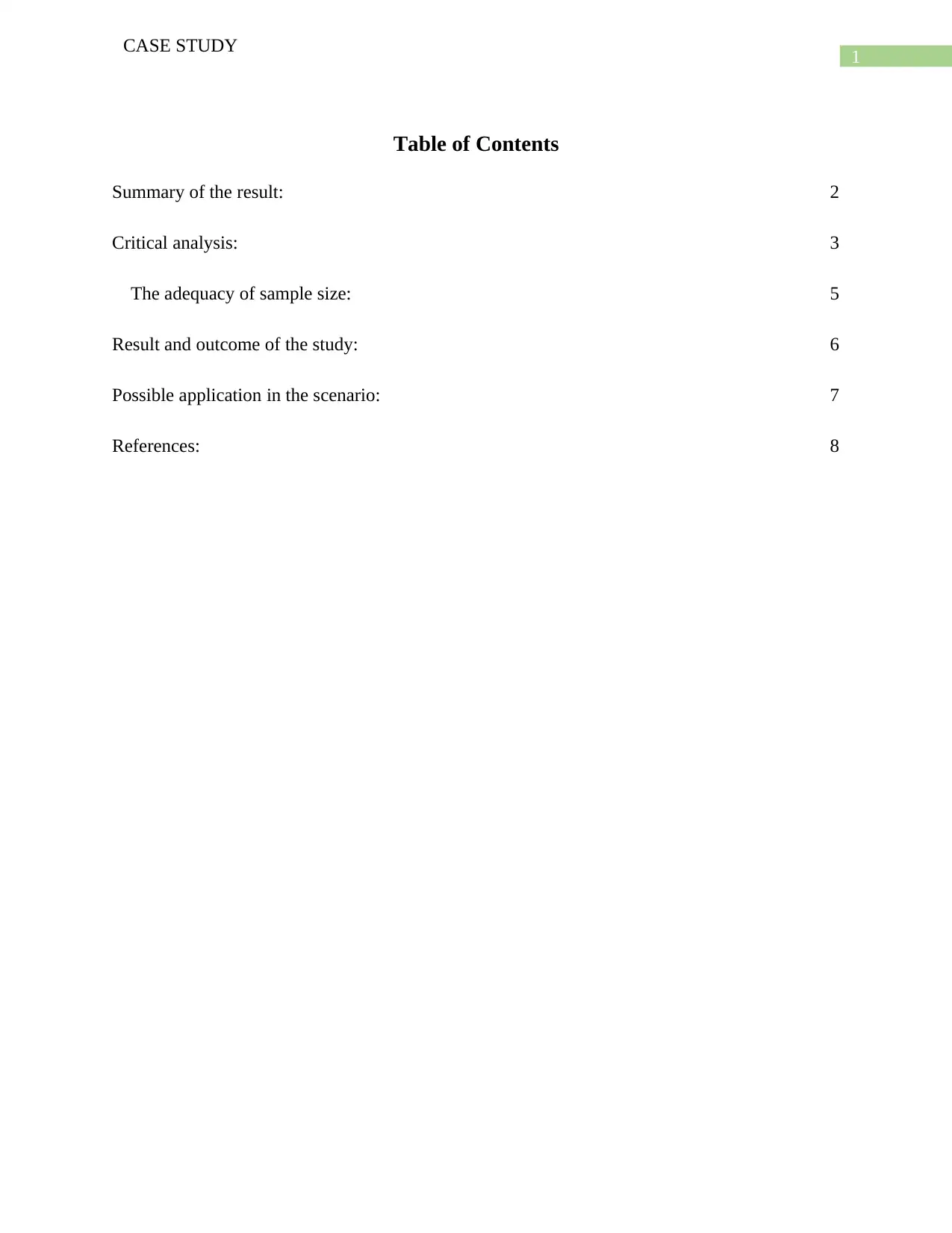
1
CASE STUDY
Table of Contents
Summary of the result: 2
Critical analysis: 3
The adequacy of sample size: 5
Result and outcome of the study: 6
Possible application in the scenario: 7
References: 8
CASE STUDY
Table of Contents
Summary of the result: 2
Critical analysis: 3
The adequacy of sample size: 5
Result and outcome of the study: 6
Possible application in the scenario: 7
References: 8
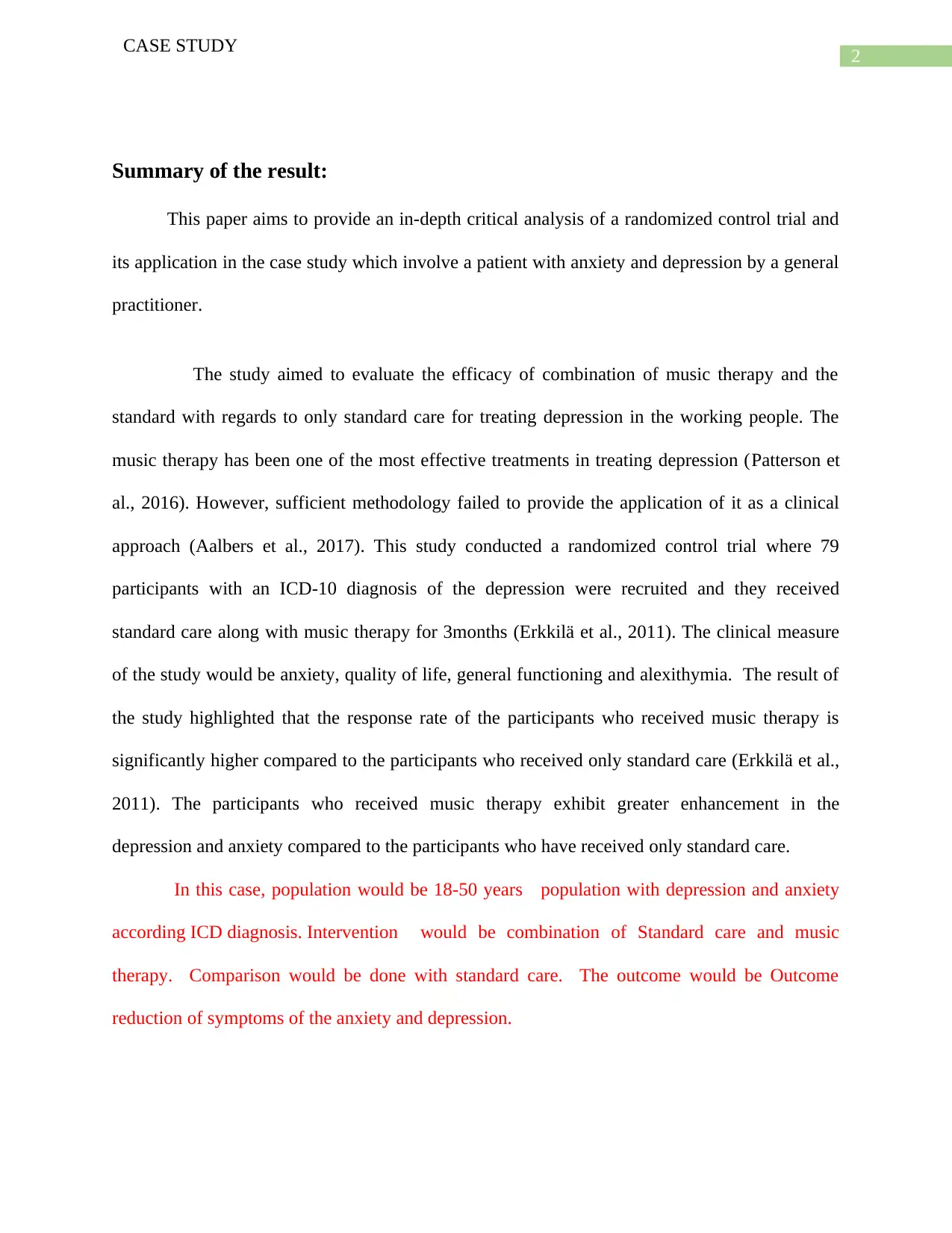
2
CASE STUDY
Summary of the result:
This paper aims to provide an in-depth critical analysis of a randomized control trial and
its application in the case study which involve a patient with anxiety and depression by a general
practitioner.
The study aimed to evaluate the efficacy of combination of music therapy and the
standard with regards to only standard care for treating depression in the working people. The
music therapy has been one of the most effective treatments in treating depression (Patterson et
al., 2016). However, sufficient methodology failed to provide the application of it as a clinical
approach (Aalbers et al., 2017). This study conducted a randomized control trial where 79
participants with an ICD-10 diagnosis of the depression were recruited and they received
standard care along with music therapy for 3months (Erkkilä et al., 2011). The clinical measure
of the study would be anxiety, quality of life, general functioning and alexithymia. The result of
the study highlighted that the response rate of the participants who received music therapy is
significantly higher compared to the participants who received only standard care (Erkkilä et al.,
2011). The participants who received music therapy exhibit greater enhancement in the
depression and anxiety compared to the participants who have received only standard care.
In this case, population would be 18-50 years population with depression and anxiety
according ICD diagnosis. Intervention would be combination of Standard care and music
therapy. Comparison would be done with standard care. The outcome would be Outcome
reduction of symptoms of the anxiety and depression.
CASE STUDY
Summary of the result:
This paper aims to provide an in-depth critical analysis of a randomized control trial and
its application in the case study which involve a patient with anxiety and depression by a general
practitioner.
The study aimed to evaluate the efficacy of combination of music therapy and the
standard with regards to only standard care for treating depression in the working people. The
music therapy has been one of the most effective treatments in treating depression (Patterson et
al., 2016). However, sufficient methodology failed to provide the application of it as a clinical
approach (Aalbers et al., 2017). This study conducted a randomized control trial where 79
participants with an ICD-10 diagnosis of the depression were recruited and they received
standard care along with music therapy for 3months (Erkkilä et al., 2011). The clinical measure
of the study would be anxiety, quality of life, general functioning and alexithymia. The result of
the study highlighted that the response rate of the participants who received music therapy is
significantly higher compared to the participants who received only standard care (Erkkilä et al.,
2011). The participants who received music therapy exhibit greater enhancement in the
depression and anxiety compared to the participants who have received only standard care.
In this case, population would be 18-50 years population with depression and anxiety
according ICD diagnosis. Intervention would be combination of Standard care and music
therapy. Comparison would be done with standard care. The outcome would be Outcome
reduction of symptoms of the anxiety and depression.
⊘ This is a preview!⊘
Do you want full access?
Subscribe today to unlock all pages.

Trusted by 1+ million students worldwide
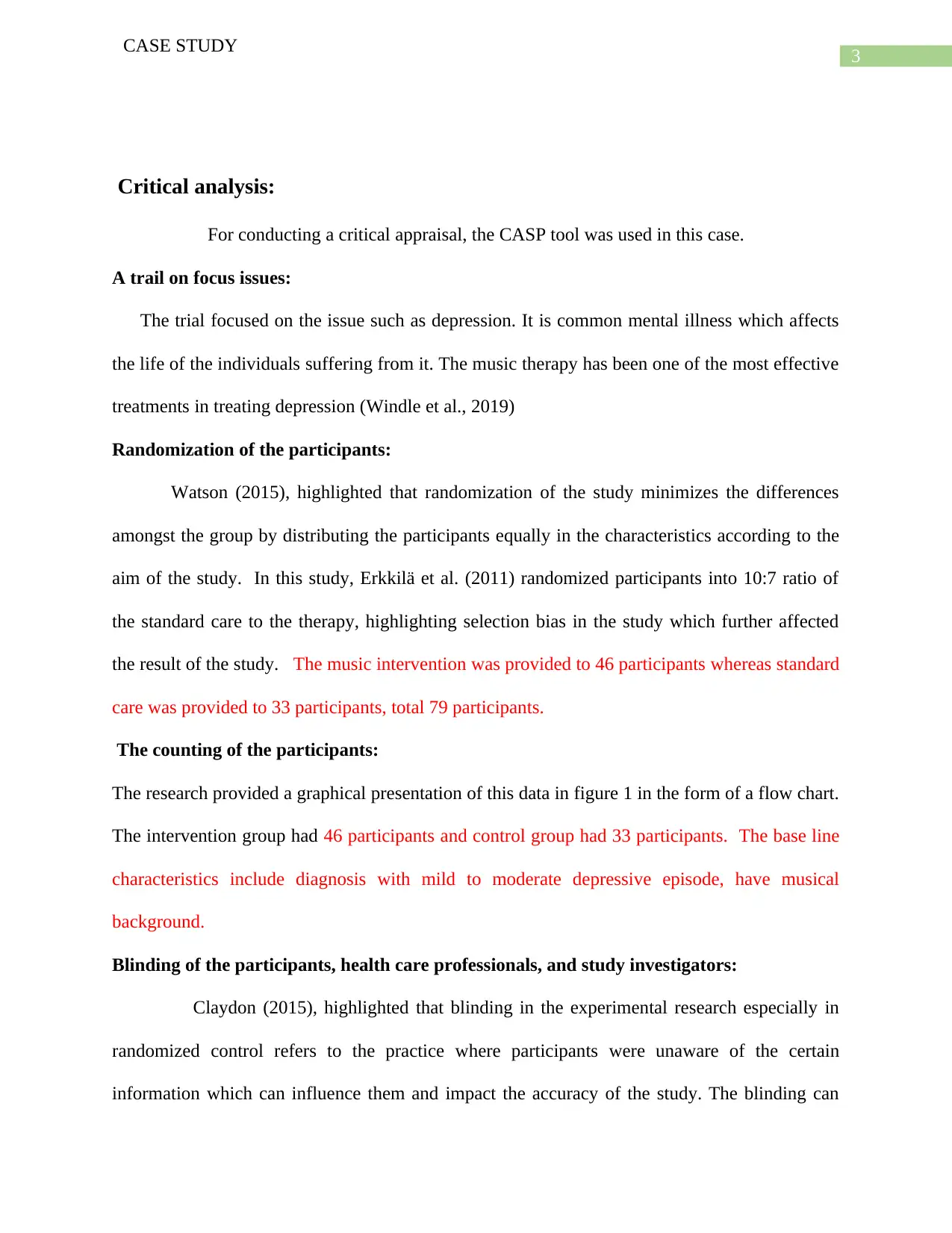
3
CASE STUDY
Critical analysis:
For conducting a critical appraisal, the CASP tool was used in this case.
A trail on focus issues:
The trial focused on the issue such as depression. It is common mental illness which affects
the life of the individuals suffering from it. The music therapy has been one of the most effective
treatments in treating depression (Windle et al., 2019)
Randomization of the participants:
Watson (2015), highlighted that randomization of the study minimizes the differences
amongst the group by distributing the participants equally in the characteristics according to the
aim of the study. In this study, Erkkilä et al. (2011) randomized participants into 10:7 ratio of
the standard care to the therapy, highlighting selection bias in the study which further affected
the result of the study. The music intervention was provided to 46 participants whereas standard
care was provided to 33 participants, total 79 participants.
The counting of the participants:
The research provided a graphical presentation of this data in figure 1 in the form of a flow chart.
The intervention group had 46 participants and control group had 33 participants. The base line
characteristics include diagnosis with mild to moderate depressive episode, have musical
background.
Blinding of the participants, health care professionals, and study investigators:
Claydon (2015), highlighted that blinding in the experimental research especially in
randomized control refers to the practice where participants were unaware of the certain
information which can influence them and impact the accuracy of the study. The blinding can
CASE STUDY
Critical analysis:
For conducting a critical appraisal, the CASP tool was used in this case.
A trail on focus issues:
The trial focused on the issue such as depression. It is common mental illness which affects
the life of the individuals suffering from it. The music therapy has been one of the most effective
treatments in treating depression (Windle et al., 2019)
Randomization of the participants:
Watson (2015), highlighted that randomization of the study minimizes the differences
amongst the group by distributing the participants equally in the characteristics according to the
aim of the study. In this study, Erkkilä et al. (2011) randomized participants into 10:7 ratio of
the standard care to the therapy, highlighting selection bias in the study which further affected
the result of the study. The music intervention was provided to 46 participants whereas standard
care was provided to 33 participants, total 79 participants.
The counting of the participants:
The research provided a graphical presentation of this data in figure 1 in the form of a flow chart.
The intervention group had 46 participants and control group had 33 participants. The base line
characteristics include diagnosis with mild to moderate depressive episode, have musical
background.
Blinding of the participants, health care professionals, and study investigators:
Claydon (2015), highlighted that blinding in the experimental research especially in
randomized control refers to the practice where participants were unaware of the certain
information which can influence them and impact the accuracy of the study. The blinding can
Paraphrase This Document
Need a fresh take? Get an instant paraphrase of this document with our AI Paraphraser
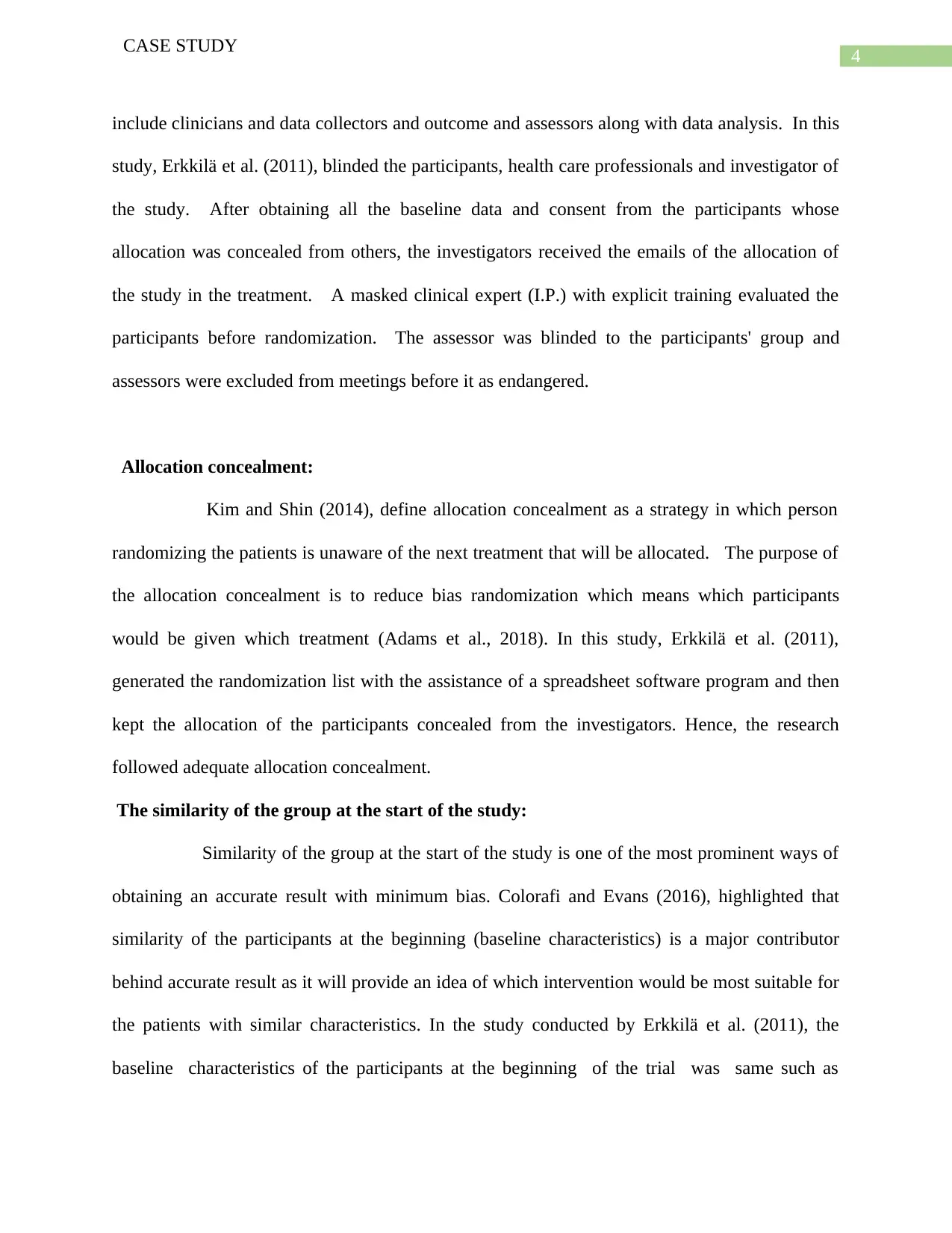
4
CASE STUDY
include clinicians and data collectors and outcome and assessors along with data analysis. In this
study, Erkkilä et al. (2011), blinded the participants, health care professionals and investigator of
the study. After obtaining all the baseline data and consent from the participants whose
allocation was concealed from others, the investigators received the emails of the allocation of
the study in the treatment. A masked clinical expert (I.P.) with explicit training evaluated the
participants before randomization. The assessor was blinded to the participants' group and
assessors were excluded from meetings before it as endangered.
Allocation concealment:
Kim and Shin (2014), define allocation concealment as a strategy in which person
randomizing the patients is unaware of the next treatment that will be allocated. The purpose of
the allocation concealment is to reduce bias randomization which means which participants
would be given which treatment (Adams et al., 2018). In this study, Erkkilä et al. (2011),
generated the randomization list with the assistance of a spreadsheet software program and then
kept the allocation of the participants concealed from the investigators. Hence, the research
followed adequate allocation concealment.
The similarity of the group at the start of the study:
Similarity of the group at the start of the study is one of the most prominent ways of
obtaining an accurate result with minimum bias. Colorafi and Evans (2016), highlighted that
similarity of the participants at the beginning (baseline characteristics) is a major contributor
behind accurate result as it will provide an idea of which intervention would be most suitable for
the patients with similar characteristics. In the study conducted by Erkkilä et al. (2011), the
baseline characteristics of the participants at the beginning of the trial was same such as
CASE STUDY
include clinicians and data collectors and outcome and assessors along with data analysis. In this
study, Erkkilä et al. (2011), blinded the participants, health care professionals and investigator of
the study. After obtaining all the baseline data and consent from the participants whose
allocation was concealed from others, the investigators received the emails of the allocation of
the study in the treatment. A masked clinical expert (I.P.) with explicit training evaluated the
participants before randomization. The assessor was blinded to the participants' group and
assessors were excluded from meetings before it as endangered.
Allocation concealment:
Kim and Shin (2014), define allocation concealment as a strategy in which person
randomizing the patients is unaware of the next treatment that will be allocated. The purpose of
the allocation concealment is to reduce bias randomization which means which participants
would be given which treatment (Adams et al., 2018). In this study, Erkkilä et al. (2011),
generated the randomization list with the assistance of a spreadsheet software program and then
kept the allocation of the participants concealed from the investigators. Hence, the research
followed adequate allocation concealment.
The similarity of the group at the start of the study:
Similarity of the group at the start of the study is one of the most prominent ways of
obtaining an accurate result with minimum bias. Colorafi and Evans (2016), highlighted that
similarity of the participants at the beginning (baseline characteristics) is a major contributor
behind accurate result as it will provide an idea of which intervention would be most suitable for
the patients with similar characteristics. In the study conducted by Erkkilä et al. (2011), the
baseline characteristics of the participants at the beginning of the trial was same such as
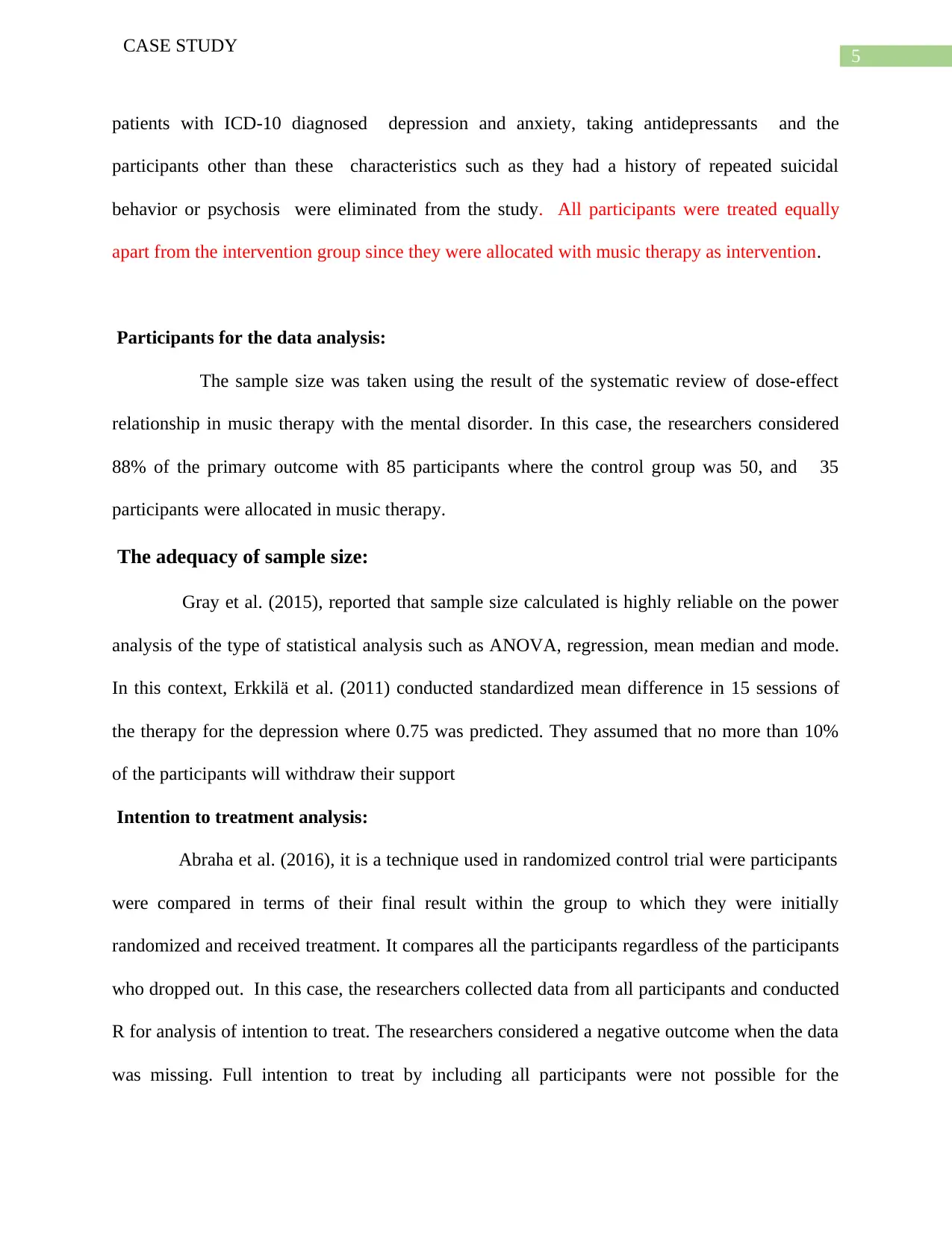
5
CASE STUDY
patients with ICD-10 diagnosed depression and anxiety, taking antidepressants and the
participants other than these characteristics such as they had a history of repeated suicidal
behavior or psychosis were eliminated from the study. All participants were treated equally
apart from the intervention group since they were allocated with music therapy as intervention.
Participants for the data analysis:
The sample size was taken using the result of the systematic review of dose-effect
relationship in music therapy with the mental disorder. In this case, the researchers considered
88% of the primary outcome with 85 participants where the control group was 50, and 35
participants were allocated in music therapy.
The adequacy of sample size:
Gray et al. (2015), reported that sample size calculated is highly reliable on the power
analysis of the type of statistical analysis such as ANOVA, regression, mean median and mode.
In this context, Erkkilä et al. (2011) conducted standardized mean difference in 15 sessions of
the therapy for the depression where 0.75 was predicted. They assumed that no more than 10%
of the participants will withdraw their support
Intention to treatment analysis:
Abraha et al. (2016), it is a technique used in randomized control trial were participants
were compared in terms of their final result within the group to which they were initially
randomized and received treatment. It compares all the participants regardless of the participants
who dropped out. In this case, the researchers collected data from all participants and conducted
R for analysis of intention to treat. The researchers considered a negative outcome when the data
was missing. Full intention to treat by including all participants were not possible for the
CASE STUDY
patients with ICD-10 diagnosed depression and anxiety, taking antidepressants and the
participants other than these characteristics such as they had a history of repeated suicidal
behavior or psychosis were eliminated from the study. All participants were treated equally
apart from the intervention group since they were allocated with music therapy as intervention.
Participants for the data analysis:
The sample size was taken using the result of the systematic review of dose-effect
relationship in music therapy with the mental disorder. In this case, the researchers considered
88% of the primary outcome with 85 participants where the control group was 50, and 35
participants were allocated in music therapy.
The adequacy of sample size:
Gray et al. (2015), reported that sample size calculated is highly reliable on the power
analysis of the type of statistical analysis such as ANOVA, regression, mean median and mode.
In this context, Erkkilä et al. (2011) conducted standardized mean difference in 15 sessions of
the therapy for the depression where 0.75 was predicted. They assumed that no more than 10%
of the participants will withdraw their support
Intention to treatment analysis:
Abraha et al. (2016), it is a technique used in randomized control trial were participants
were compared in terms of their final result within the group to which they were initially
randomized and received treatment. It compares all the participants regardless of the participants
who dropped out. In this case, the researchers collected data from all participants and conducted
R for analysis of intention to treat. The researchers considered a negative outcome when the data
was missing. Full intention to treat by including all participants were not possible for the
⊘ This is a preview!⊘
Do you want full access?
Subscribe today to unlock all pages.

Trusted by 1+ million students worldwide
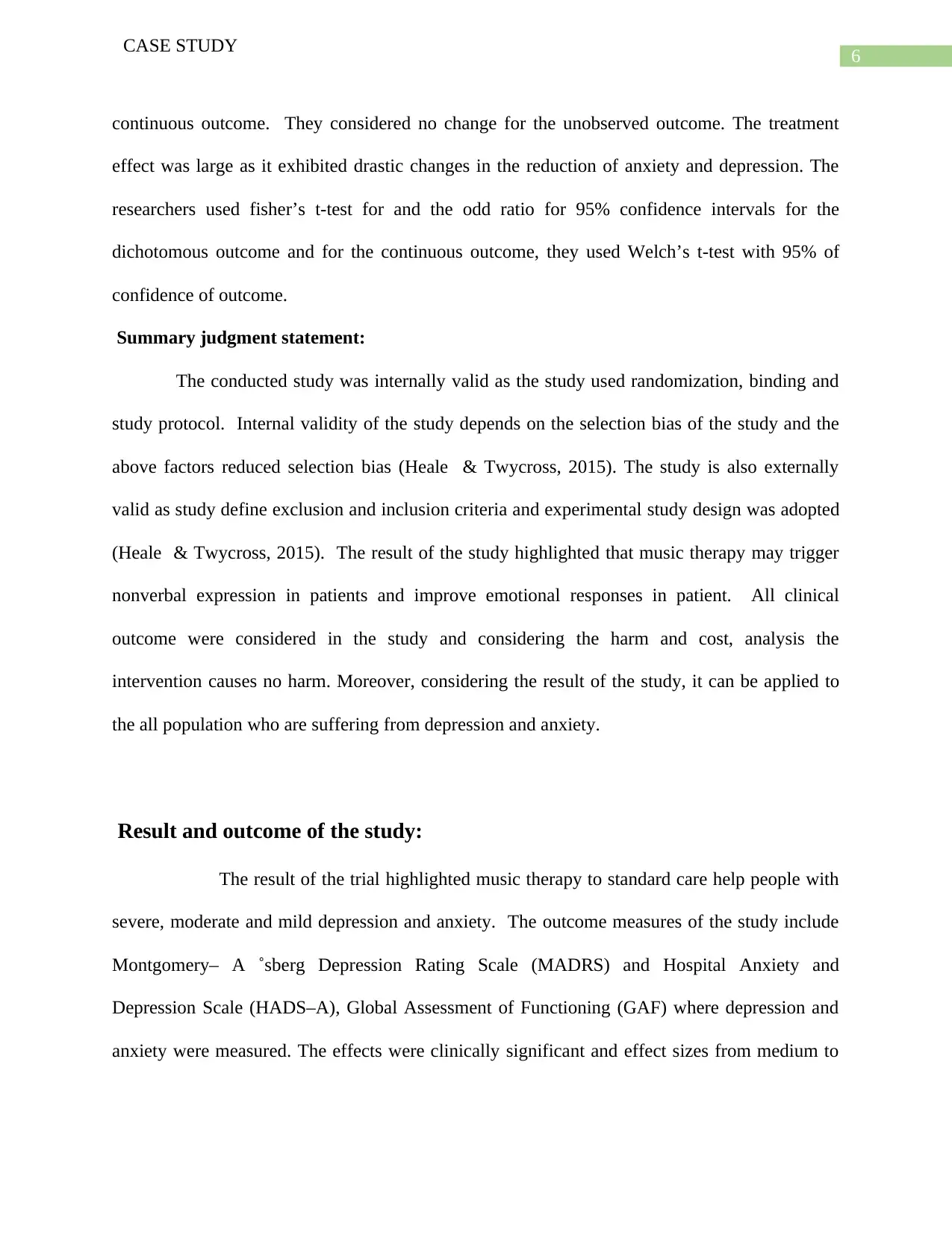
6
CASE STUDY
continuous outcome. They considered no change for the unobserved outcome. The treatment
effect was large as it exhibited drastic changes in the reduction of anxiety and depression. The
researchers used fisher’s t-test for and the odd ratio for 95% confidence intervals for the
dichotomous outcome and for the continuous outcome, they used Welch’s t-test with 95% of
confidence of outcome.
Summary judgment statement:
The conducted study was internally valid as the study used randomization, binding and
study protocol. Internal validity of the study depends on the selection bias of the study and the
above factors reduced selection bias (Heale & Twycross, 2015). The study is also externally
valid as study define exclusion and inclusion criteria and experimental study design was adopted
(Heale & Twycross, 2015). The result of the study highlighted that music therapy may trigger
nonverbal expression in patients and improve emotional responses in patient. All clinical
outcome were considered in the study and considering the harm and cost, analysis the
intervention causes no harm. Moreover, considering the result of the study, it can be applied to
the all population who are suffering from depression and anxiety.
Result and outcome of the study:
The result of the trial highlighted music therapy to standard care help people with
severe, moderate and mild depression and anxiety. The outcome measures of the study include
Montgomery– A ˚sberg Depression Rating Scale (MADRS) and Hospital Anxiety and
Depression Scale (HADS–A), Global Assessment of Functioning (GAF) where depression and
anxiety were measured. The effects were clinically significant and effect sizes from medium to
CASE STUDY
continuous outcome. They considered no change for the unobserved outcome. The treatment
effect was large as it exhibited drastic changes in the reduction of anxiety and depression. The
researchers used fisher’s t-test for and the odd ratio for 95% confidence intervals for the
dichotomous outcome and for the continuous outcome, they used Welch’s t-test with 95% of
confidence of outcome.
Summary judgment statement:
The conducted study was internally valid as the study used randomization, binding and
study protocol. Internal validity of the study depends on the selection bias of the study and the
above factors reduced selection bias (Heale & Twycross, 2015). The study is also externally
valid as study define exclusion and inclusion criteria and experimental study design was adopted
(Heale & Twycross, 2015). The result of the study highlighted that music therapy may trigger
nonverbal expression in patients and improve emotional responses in patient. All clinical
outcome were considered in the study and considering the harm and cost, analysis the
intervention causes no harm. Moreover, considering the result of the study, it can be applied to
the all population who are suffering from depression and anxiety.
Result and outcome of the study:
The result of the trial highlighted music therapy to standard care help people with
severe, moderate and mild depression and anxiety. The outcome measures of the study include
Montgomery– A ˚sberg Depression Rating Scale (MADRS) and Hospital Anxiety and
Depression Scale (HADS–A), Global Assessment of Functioning (GAF) where depression and
anxiety were measured. The effects were clinically significant and effect sizes from medium to
Paraphrase This Document
Need a fresh take? Get an instant paraphrase of this document with our AI Paraphraser
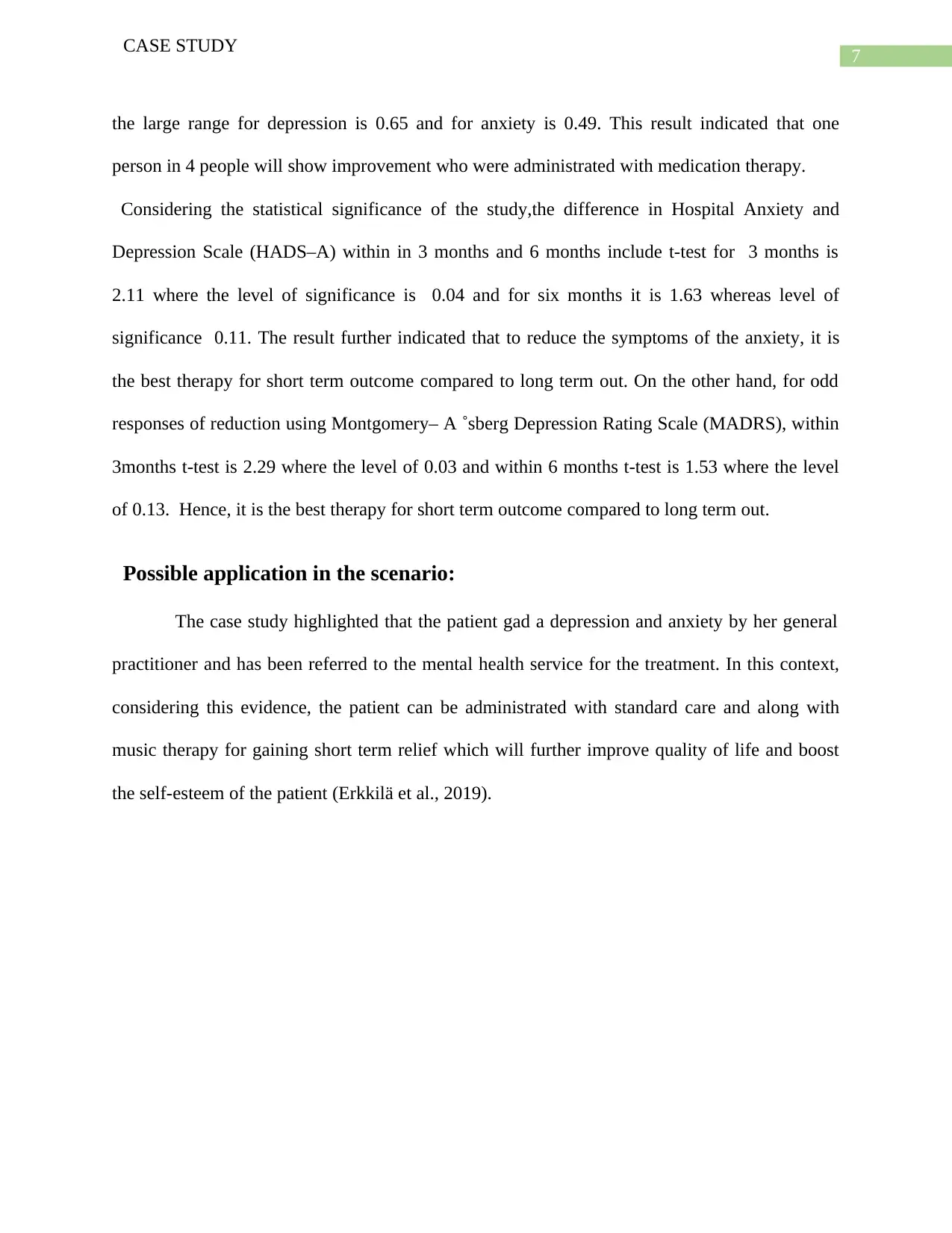
7
CASE STUDY
the large range for depression is 0.65 and for anxiety is 0.49. This result indicated that one
person in 4 people will show improvement who were administrated with medication therapy.
Considering the statistical significance of the study,the difference in Hospital Anxiety and
Depression Scale (HADS–A) within in 3 months and 6 months include t-test for 3 months is
2.11 where the level of significance is 0.04 and for six months it is 1.63 whereas level of
significance 0.11. The result further indicated that to reduce the symptoms of the anxiety, it is
the best therapy for short term outcome compared to long term out. On the other hand, for odd
responses of reduction using Montgomery– A ˚sberg Depression Rating Scale (MADRS), within
3months t-test is 2.29 where the level of 0.03 and within 6 months t-test is 1.53 where the level
of 0.13. Hence, it is the best therapy for short term outcome compared to long term out.
Possible application in the scenario:
The case study highlighted that the patient gad a depression and anxiety by her general
practitioner and has been referred to the mental health service for the treatment. In this context,
considering this evidence, the patient can be administrated with standard care and along with
music therapy for gaining short term relief which will further improve quality of life and boost
the self-esteem of the patient (Erkkilä et al., 2019).
CASE STUDY
the large range for depression is 0.65 and for anxiety is 0.49. This result indicated that one
person in 4 people will show improvement who were administrated with medication therapy.
Considering the statistical significance of the study,the difference in Hospital Anxiety and
Depression Scale (HADS–A) within in 3 months and 6 months include t-test for 3 months is
2.11 where the level of significance is 0.04 and for six months it is 1.63 whereas level of
significance 0.11. The result further indicated that to reduce the symptoms of the anxiety, it is
the best therapy for short term outcome compared to long term out. On the other hand, for odd
responses of reduction using Montgomery– A ˚sberg Depression Rating Scale (MADRS), within
3months t-test is 2.29 where the level of 0.03 and within 6 months t-test is 1.53 where the level
of 0.13. Hence, it is the best therapy for short term outcome compared to long term out.
Possible application in the scenario:
The case study highlighted that the patient gad a depression and anxiety by her general
practitioner and has been referred to the mental health service for the treatment. In this context,
considering this evidence, the patient can be administrated with standard care and along with
music therapy for gaining short term relief which will further improve quality of life and boost
the self-esteem of the patient (Erkkilä et al., 2019).
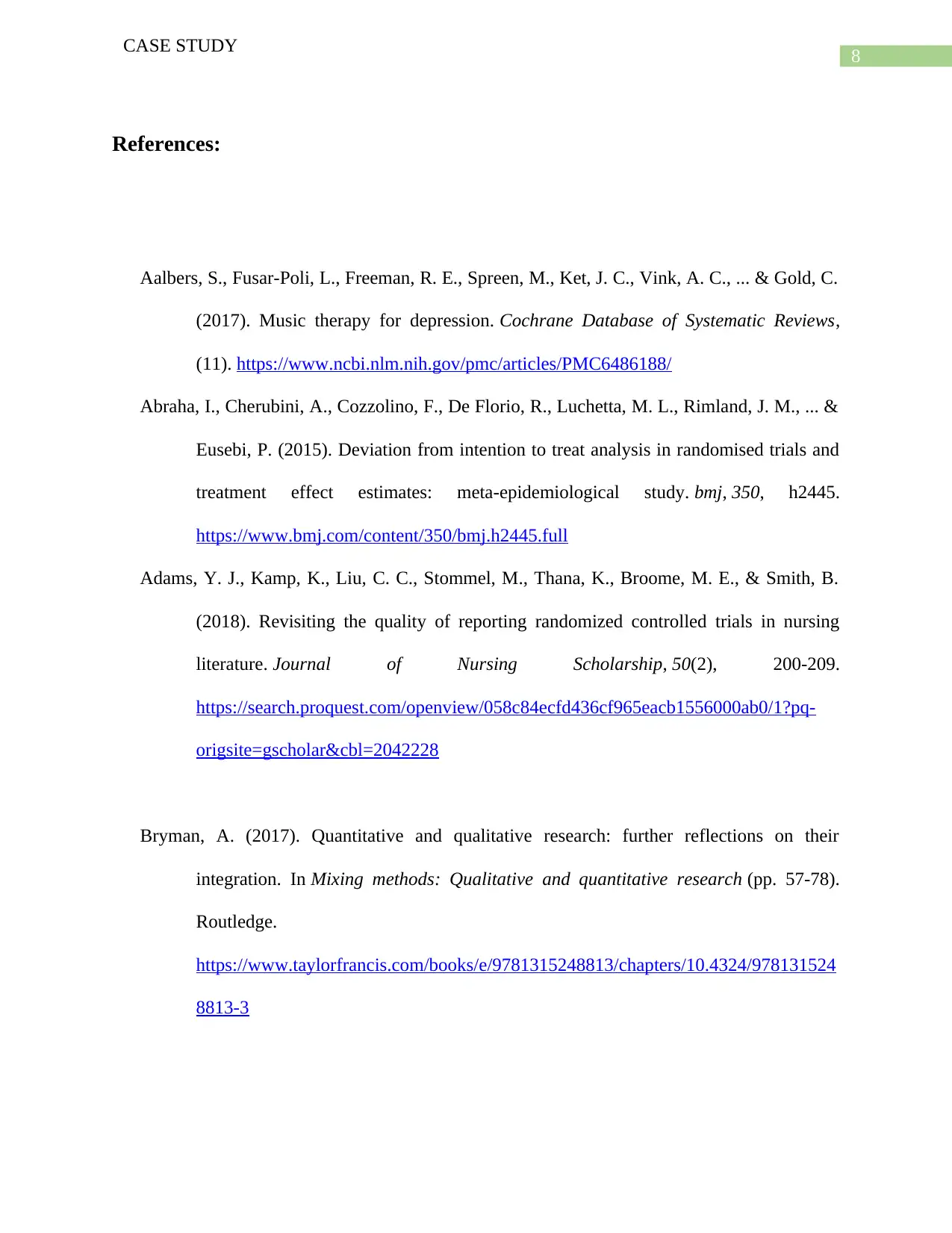
8
CASE STUDY
References:
Aalbers, S., Fusar‐Poli, L., Freeman, R. E., Spreen, M., Ket, J. C., Vink, A. C., ... & Gold, C.
(2017). Music therapy for depression. Cochrane Database of Systematic Reviews,
(11). https://www.ncbi.nlm.nih.gov/pmc/articles/PMC6486188/
Abraha, I., Cherubini, A., Cozzolino, F., De Florio, R., Luchetta, M. L., Rimland, J. M., ... &
Eusebi, P. (2015). Deviation from intention to treat analysis in randomised trials and
treatment effect estimates: meta-epidemiological study. bmj, 350, h2445.
https://www.bmj.com/content/350/bmj.h2445.full
Adams, Y. J., Kamp, K., Liu, C. C., Stommel, M., Thana, K., Broome, M. E., & Smith, B.
(2018). Revisiting the quality of reporting randomized controlled trials in nursing
literature. Journal of Nursing Scholarship, 50(2), 200-209.
https://search.proquest.com/openview/058c84ecfd436cf965eacb1556000ab0/1?pq-
origsite=gscholar&cbl=2042228
Bryman, A. (2017). Quantitative and qualitative research: further reflections on their
integration. In Mixing methods: Qualitative and quantitative research (pp. 57-78).
Routledge.
https://www.taylorfrancis.com/books/e/9781315248813/chapters/10.4324/978131524
8813-3
CASE STUDY
References:
Aalbers, S., Fusar‐Poli, L., Freeman, R. E., Spreen, M., Ket, J. C., Vink, A. C., ... & Gold, C.
(2017). Music therapy for depression. Cochrane Database of Systematic Reviews,
(11). https://www.ncbi.nlm.nih.gov/pmc/articles/PMC6486188/
Abraha, I., Cherubini, A., Cozzolino, F., De Florio, R., Luchetta, M. L., Rimland, J. M., ... &
Eusebi, P. (2015). Deviation from intention to treat analysis in randomised trials and
treatment effect estimates: meta-epidemiological study. bmj, 350, h2445.
https://www.bmj.com/content/350/bmj.h2445.full
Adams, Y. J., Kamp, K., Liu, C. C., Stommel, M., Thana, K., Broome, M. E., & Smith, B.
(2018). Revisiting the quality of reporting randomized controlled trials in nursing
literature. Journal of Nursing Scholarship, 50(2), 200-209.
https://search.proquest.com/openview/058c84ecfd436cf965eacb1556000ab0/1?pq-
origsite=gscholar&cbl=2042228
Bryman, A. (2017). Quantitative and qualitative research: further reflections on their
integration. In Mixing methods: Qualitative and quantitative research (pp. 57-78).
Routledge.
https://www.taylorfrancis.com/books/e/9781315248813/chapters/10.4324/978131524
8813-3
⊘ This is a preview!⊘
Do you want full access?
Subscribe today to unlock all pages.

Trusted by 1+ million students worldwide
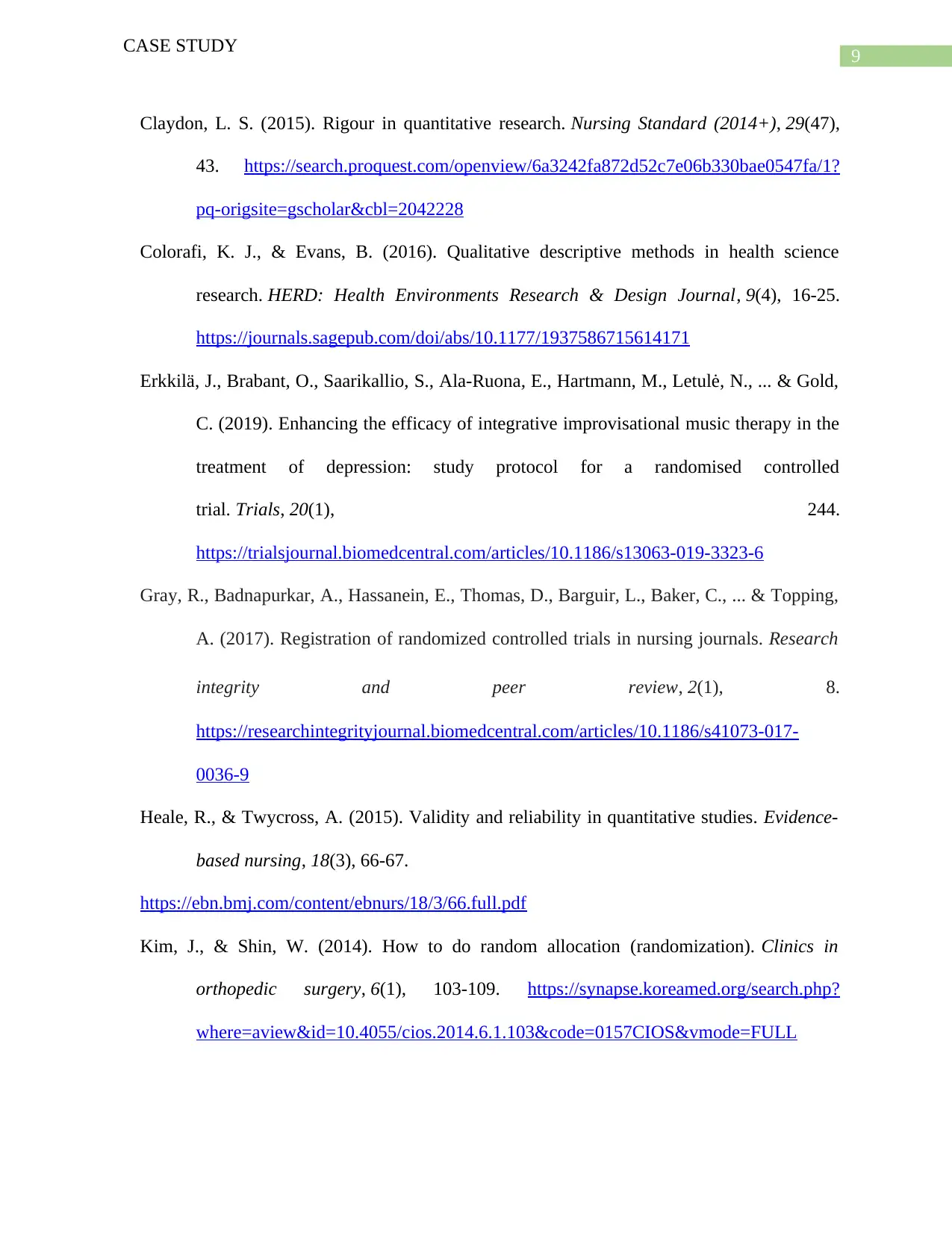
9
CASE STUDY
Claydon, L. S. (2015). Rigour in quantitative research. Nursing Standard (2014+), 29(47),
43. https://search.proquest.com/openview/6a3242fa872d52c7e06b330bae0547fa/1?
pq-origsite=gscholar&cbl=2042228
Colorafi, K. J., & Evans, B. (2016). Qualitative descriptive methods in health science
research. HERD: Health Environments Research & Design Journal, 9(4), 16-25.
https://journals.sagepub.com/doi/abs/10.1177/1937586715614171
Erkkilä, J., Brabant, O., Saarikallio, S., Ala-Ruona, E., Hartmann, M., Letulė, N., ... & Gold,
C. (2019). Enhancing the efficacy of integrative improvisational music therapy in the
treatment of depression: study protocol for a randomised controlled
trial. Trials, 20(1), 244.
https://trialsjournal.biomedcentral.com/articles/10.1186/s13063-019-3323-6
Gray, R., Badnapurkar, A., Hassanein, E., Thomas, D., Barguir, L., Baker, C., ... & Topping,
A. (2017). Registration of randomized controlled trials in nursing journals. Research
integrity and peer review, 2(1), 8.
https://researchintegrityjournal.biomedcentral.com/articles/10.1186/s41073-017-
0036-9
Heale, R., & Twycross, A. (2015). Validity and reliability in quantitative studies. Evidence-
based nursing, 18(3), 66-67.
https://ebn.bmj.com/content/ebnurs/18/3/66.full.pdf
Kim, J., & Shin, W. (2014). How to do random allocation (randomization). Clinics in
orthopedic surgery, 6(1), 103-109. https://synapse.koreamed.org/search.php?
where=aview&id=10.4055/cios.2014.6.1.103&code=0157CIOS&vmode=FULL
CASE STUDY
Claydon, L. S. (2015). Rigour in quantitative research. Nursing Standard (2014+), 29(47),
43. https://search.proquest.com/openview/6a3242fa872d52c7e06b330bae0547fa/1?
pq-origsite=gscholar&cbl=2042228
Colorafi, K. J., & Evans, B. (2016). Qualitative descriptive methods in health science
research. HERD: Health Environments Research & Design Journal, 9(4), 16-25.
https://journals.sagepub.com/doi/abs/10.1177/1937586715614171
Erkkilä, J., Brabant, O., Saarikallio, S., Ala-Ruona, E., Hartmann, M., Letulė, N., ... & Gold,
C. (2019). Enhancing the efficacy of integrative improvisational music therapy in the
treatment of depression: study protocol for a randomised controlled
trial. Trials, 20(1), 244.
https://trialsjournal.biomedcentral.com/articles/10.1186/s13063-019-3323-6
Gray, R., Badnapurkar, A., Hassanein, E., Thomas, D., Barguir, L., Baker, C., ... & Topping,
A. (2017). Registration of randomized controlled trials in nursing journals. Research
integrity and peer review, 2(1), 8.
https://researchintegrityjournal.biomedcentral.com/articles/10.1186/s41073-017-
0036-9
Heale, R., & Twycross, A. (2015). Validity and reliability in quantitative studies. Evidence-
based nursing, 18(3), 66-67.
https://ebn.bmj.com/content/ebnurs/18/3/66.full.pdf
Kim, J., & Shin, W. (2014). How to do random allocation (randomization). Clinics in
orthopedic surgery, 6(1), 103-109. https://synapse.koreamed.org/search.php?
where=aview&id=10.4055/cios.2014.6.1.103&code=0157CIOS&vmode=FULL
Paraphrase This Document
Need a fresh take? Get an instant paraphrase of this document with our AI Paraphraser
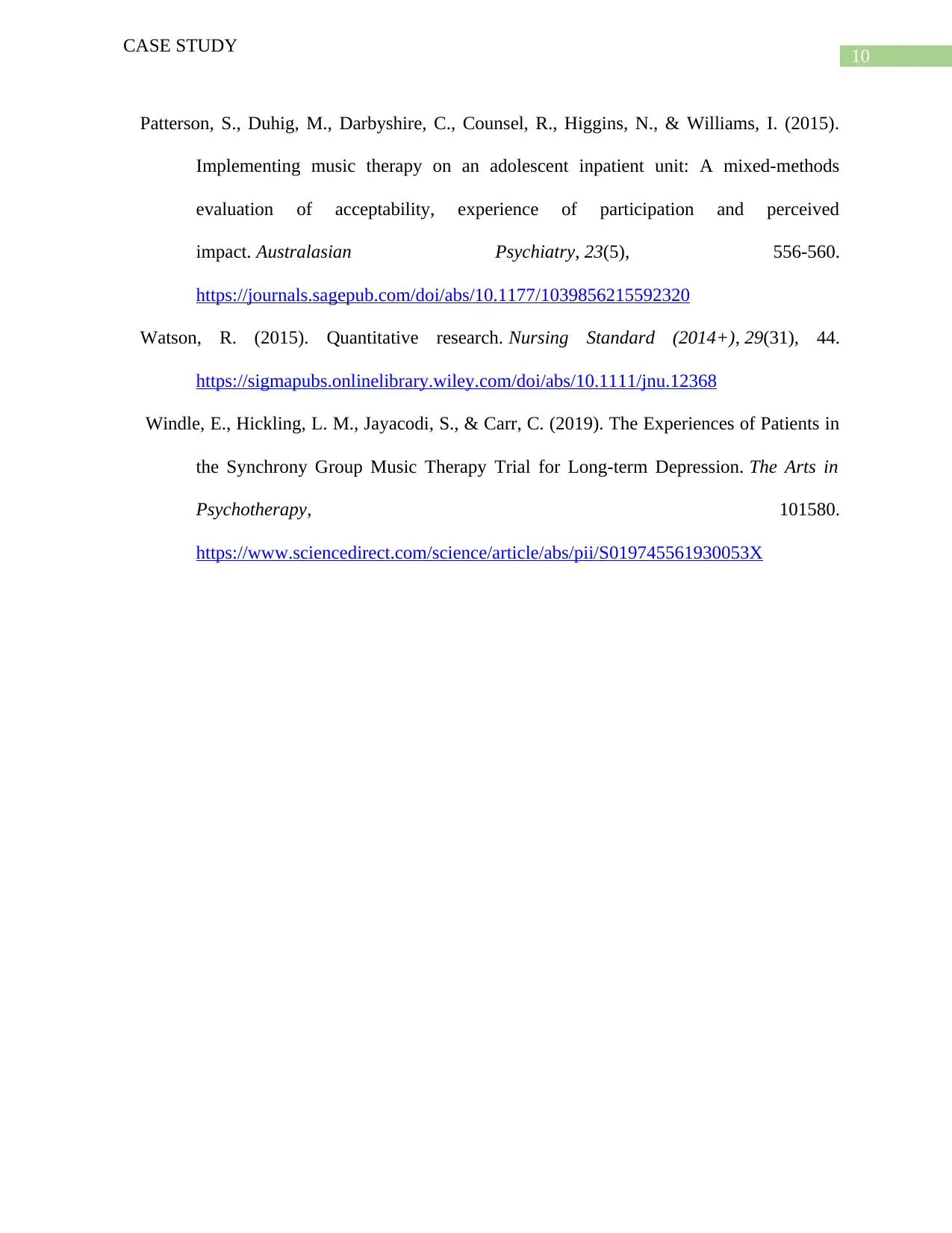
10
CASE STUDY
Patterson, S., Duhig, M., Darbyshire, C., Counsel, R., Higgins, N., & Williams, I. (2015).
Implementing music therapy on an adolescent inpatient unit: A mixed-methods
evaluation of acceptability, experience of participation and perceived
impact. Australasian Psychiatry, 23(5), 556-560.
https://journals.sagepub.com/doi/abs/10.1177/1039856215592320
Watson, R. (2015). Quantitative research. Nursing Standard (2014+), 29(31), 44.
https://sigmapubs.onlinelibrary.wiley.com/doi/abs/10.1111/jnu.12368
Windle, E., Hickling, L. M., Jayacodi, S., & Carr, C. (2019). The Experiences of Patients in
the Synchrony Group Music Therapy Trial for Long-term Depression. The Arts in
Psychotherapy, 101580.
https://www.sciencedirect.com/science/article/abs/pii/S019745561930053X
CASE STUDY
Patterson, S., Duhig, M., Darbyshire, C., Counsel, R., Higgins, N., & Williams, I. (2015).
Implementing music therapy on an adolescent inpatient unit: A mixed-methods
evaluation of acceptability, experience of participation and perceived
impact. Australasian Psychiatry, 23(5), 556-560.
https://journals.sagepub.com/doi/abs/10.1177/1039856215592320
Watson, R. (2015). Quantitative research. Nursing Standard (2014+), 29(31), 44.
https://sigmapubs.onlinelibrary.wiley.com/doi/abs/10.1111/jnu.12368
Windle, E., Hickling, L. M., Jayacodi, S., & Carr, C. (2019). The Experiences of Patients in
the Synchrony Group Music Therapy Trial for Long-term Depression. The Arts in
Psychotherapy, 101580.
https://www.sciencedirect.com/science/article/abs/pii/S019745561930053X
1 out of 11
Related Documents
Your All-in-One AI-Powered Toolkit for Academic Success.
+13062052269
info@desklib.com
Available 24*7 on WhatsApp / Email
![[object Object]](/_next/static/media/star-bottom.7253800d.svg)
Unlock your academic potential
Copyright © 2020–2025 A2Z Services. All Rights Reserved. Developed and managed by ZUCOL.





